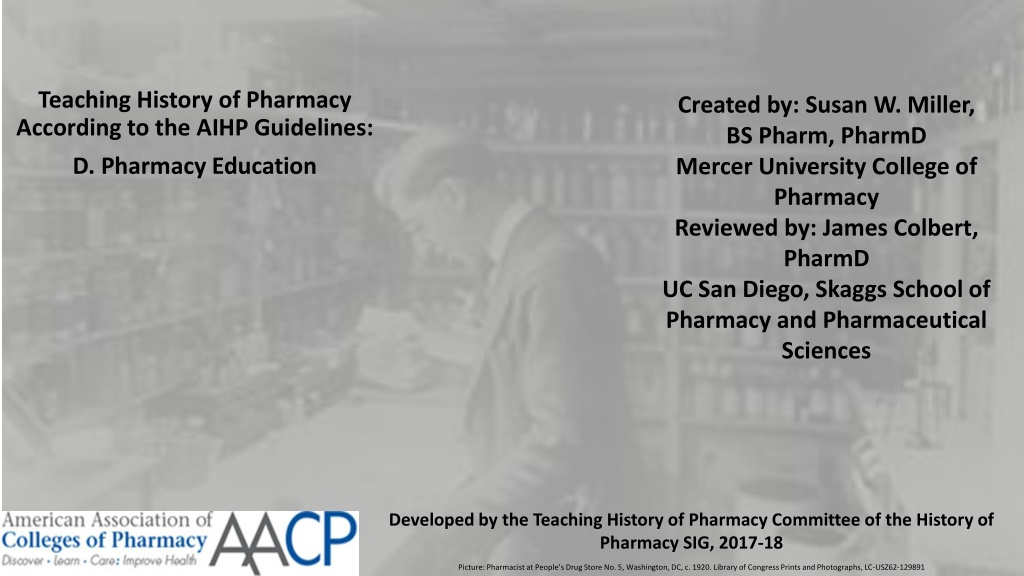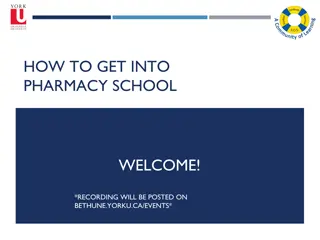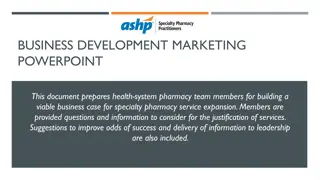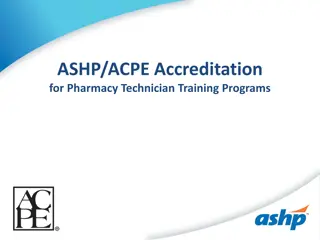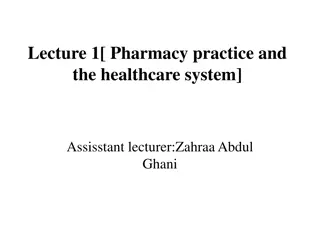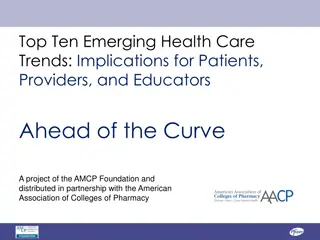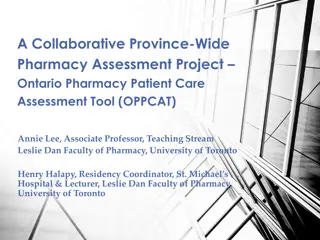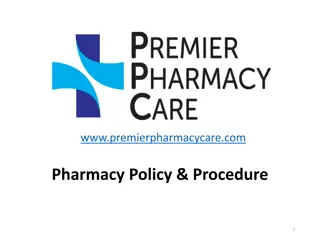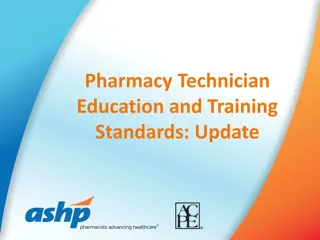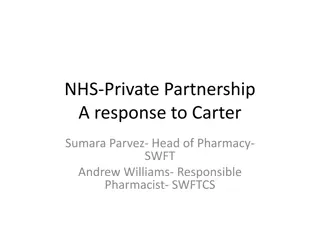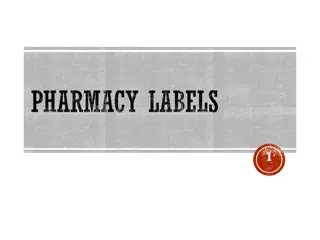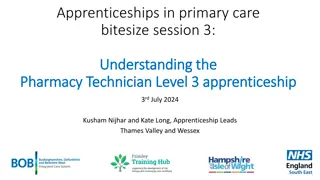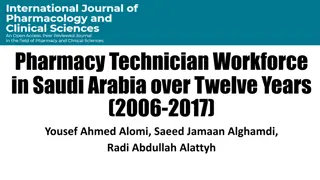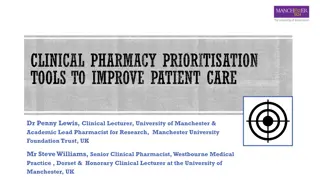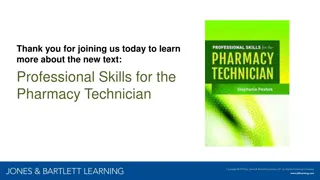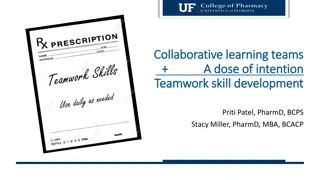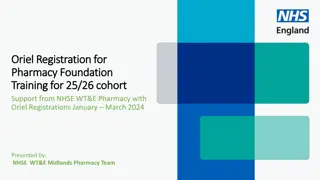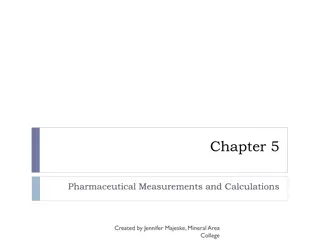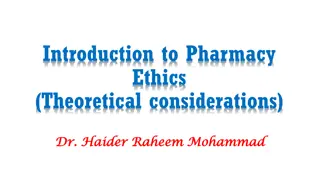Evolution of Pharmacy Education in Early U.S. History
Pharmacy education in early U.S. history evolved from an apprenticeship model in the 1700s, transitioning to independent colleges of pharmacy by the early 19th century. Originally considered an art, pharmacy education adapted to incorporate scientific principles and standardized practices, reflecting societal changes and the demand for qualified pharmacists. The separation of medicine and pharmacy, spurred by the Revolutionary War, contributed to the formalization of pharmaceutical education and the establishment of institutions dedicated to training future pharmacists.
Download Presentation

Please find below an Image/Link to download the presentation.
The content on the website is provided AS IS for your information and personal use only. It may not be sold, licensed, or shared on other websites without obtaining consent from the author. Download presentation by click this link. If you encounter any issues during the download, it is possible that the publisher has removed the file from their server.
E N D
Presentation Transcript
Teaching History of Pharmacy According to the AIHP Guidelines: Created by: Susan W. Miller, BS Pharm, PharmD Mercer University College of Pharmacy Reviewed by: James Colbert, PharmD UC San Diego, Skaggs School of Pharmacy and Pharmaceutical Sciences D. Pharmacy Education Developed by the Teaching History of Pharmacy Committee of the History of Pharmacy SIG, 2017-18 Picture: Pharmacist at People s Drug Store No. 5, Washington, DC, c. 1920. Library of Congress Prints and Photographs, LC-USZ62-129891
Early U.S. Pharmacy Education Pharmacy was considered an art and not a science in the 1700s Pharmacy education was based on the apprenticeship model Most physicians provided a shop practice with an employee apothecary and/or apprentice The apprenticeship was similar to a period of indenture (average of four years) The apprentice learned by modeling the behaviors and practices of the preceptor (physician or apothecary) The apprentice gained knowledge of chemistry and the healing properties of plants as well as the practical application of such The Revolutionary War caused a shortage of drug preparations and patent medicines sourced from Britain Druggists (wholesalers of drugs and medicines used by healers and apothecaries) rushed to learn the compounding of early drugs and patent medicines Dr. John Morgan wrote Discourse in 1760 and advocated the separation of medicine and pharmacy, with physicians writing prescriptions to be dispensed by apothecaries
Early U.S. Pharmacy Education Medical education was similar to pharmacy education with only four medical schools prior to 1800: 1765 College of Philadelphia (University of Pennsylvania) 1767 King s College (Columbia University) 1782 Harvard 1797 Dartmouth 1820 First United States Pharmacopeia (USP) published to establish uniformity in medical practices Prior to 1821 sporadic lecturers offered by chemists, apothecaries, and physicians at independent schools to supplement the apprentice training, not replace it
Early U.S. Pharmacy Education Independent Colleges of Pharmacy 1821 - Philadelphia College of Pharmacy 1823 Massachusetts College of Pharmacy 1829 College of Pharmacy of the City of New York 1840 Maryland College of Pharmacy 1850 Cincinnati College of Pharmacy No Formal Admission Process Prior apprenticeship experience preferred Attendance at occasional lectures Some laboratory instruction Graduation required passing an examination and proof of four years of apprenticeship
Early U.S. Pharmacy Education 1849 Publication of Practical Pharmacy by William Procter, Jr. First textbook of American Pharmacy 1852 - Founding of American Pharmaceutical Association (APhA) 1854 - Committee on Education of APhA expressed concerns regarding the education and training of drug clerks (employee pharmacists) Recommended reading the pharmacy literature regularly and understandingly and assist their reading by experiment and observation when necessary Schools of Pharmacy formed in one of four ways: As a private school (by a group or association of pharmacists) As a part of a university or college As a division of a medical college As a part of a state university
Early U.S. Pharmacy Education 1862 - Morrill Land Grant Act Permitted states to establish public universities to focus on education in the applied sciences , perform broad public service , and engage in activities designed to serve people 1863 Mary Corinna Putnam Jacobi - the New York College of Pharmacy First woman to graduate from a U.S. college of pharmacy 1867 Founding of Howard University College of Pharmacy The first college of pharmacy of the historically black colleges and universities The pharmacy program separated from the medicine program in 1870 1867 - Medical College of the State of South Carolina First state-supported institution to produce graduates in pharmacy 1871 to 1883 Eleven private and proprietary schools were founded Five of these eventually affiliated with private or public universities The remaining six failed
Early U.S. Pharmacy Education 1880 s to 1890 s Sources of Pharmacy Education Standard Textbooks Association Schools State Schools Correspondence Courses Home-Study Books Cramming Schools
Progress in U.S. Pharmacy Education 1884 to 1902 - Nineteen state-sponsored schools and colleges were founded Three eventually failed 1884 to 1902 Thirty-eight private, proprietary, association-based or medical school-based schools and colleges were founded Three survived Nine merged or affiliated with universities Twenty six failed 1888 APhA published the First National Formulary (NF) to standardize compound drugs 1890 APhA Section on Education and Legislation provided background and a forum for discussion on educational issues and emerging legislation impacting pharmacy
Progress in U.S. Pharmacy Education 1892 Edward Kremers of the University of Wisconsin Established first four-year baccalaureate degree in pharmacy 1892 Carl S. N. Hallberg Resolution to APhA Require theoretical education in a school or college of pharmacy as a prerequisite for examination and registration as a pharmacist Eventually withdrawn due to much criticism 1900 Two year pharmacy programs most common 1900 American Conference of Pharmaceutical Faculties (ACPF) created by the APhA Section on Education and Legislation Considered the start of the new era of progress in pharmaceutical education
Educational Criteria in Early U.S. Pharmacy Education Early 1900 s Variances in Typical Course of Study Two, three or four year programs Academic year varied from 24 weeks to 42 weeks Day and night programs were available Early 1900 s Admission Requirements No education, some high school, or high school graduate (diploma) Most colleges required only the completion of elementary or grammar school
Alliances Affect U. S. Pharmacy Education Previously Rival Factions of Pharmacy Align to Meet Challenges APhA advocated for diplomas and licenses Schools, colleges, and boards of pharmacy collaborated on apprenticeships, board examinations, and course content Boards of Pharmacy developed experience requirements for licensure and relieved schools and colleges of pharmacy of such as requirements for graduation Association Schools Continued to Advocate for Apprenticeship Model 1903 ACPF sought to bring order to pharmacy curricula with limited success 1907 Two year pharmacy program adopted as standard 1910 Publication of The Pharmaceutical Syllabus Created by the National Syllabus Committee of ACPF and NABP (National Associations of Boards of Pharmacy) Outlined a course for a two year curriculum
Progress in U.S. Pharmacy Education 1925 Three year pharmacy program was standard 1925 American Association of Colleges of Pharmacy (AACP) encompassed ACPF and approved: 1925 High school graduation as entrance requirement to pharmacy program 1928 Four year baccalaureate pharmacy program (effective in 1932) 1930 s Beginnings of postgraduate training Initially known as internships and later as residencies 1932 Founding of American Council on Pharmaceutical Education (ACPE) to accredit new pharmacy programs 1932 Four year pharmacy program adopted as standard 1946 Support of The Pharmaceutical Syllabus was withdrawn due to lack of responsiveness to change
Progress in U.S. Pharmacy Education 1946 American Council on Education (ACE) supported by grants from the American Foundation for Pharmaceutical Education initiated the Pharmaceutical Survey Survey of pharmacy deans 1948 Ohio State University pioneered the five year baccalaureate program 1949 Publication of the Pharmaceutical Survey Recommended continuous improvement of existing four year baccalaureate programs and the establishment an optional five year program leading to the Doctor of Pharmacy degree 1950 University of Southern California offered six year Doctor of Pharmacy degree as sole degree 1951 AACP delegates narrowly defeated approval of five year baccalaureate program
Progress in U.S. Pharmacy Education 1952 Publication of The Pharmaceutical Curriculum by ACPE A component of the Pharmaceutical Survey of 1946 - 1948 Vision of the necessity for a five or six-year curriculum for pharmacy education to include pre-professional education at the college level 1953 NABP passed a resolution favoring the adoption of a five-year program Received support from APhA, the American College of Apothecaries (ACA), the American Society of Hospital Pharmacists (AHSP), the National Council of State Association Secretaries Was opposed by the trade associations 1954 AACP approved a proposal to complete not less than five academic years of training for a degree in pharmacy on or after April 1, 1965
Progress in U.S. Pharmacy Education 1950 s to 1970 s Market, Consumer and Professional Forces Influence Pharmacy Education Availability of single entity drug products by drug manufacturers Consumerism s attention to professional accountability Availability of generic drug products Anti-substitution laws Interpretation of clinical data on drugs Shift from product-oriented to patient-oriented practice Emphasis on patient counseling and pharmaceutical care as the philosophy of practice 1960 s Beginnings of the clinical pharmacy movement 1962 American Society of Hospital Pharmacists accredits first residency programs Mid-1960 s ACPE added externships and courses in foundational principles of clinical pharmacy to replace analytical chemistry, pharmacognosy, and industrial pharmacy courses
Progress in U.S. Pharmacy Education Early 1970 s Schools and Colleges added many clinical faculty positions to the faculties 1975 Publication of Pharmacists for the Future by The Study Commission on Pharmacy Called on pharmacy educators to develop competency based curricula to incorporate both the common and the differential knowledge and skills required for specific practice roles 1975 Standards for approval (accreditation) of providers of continuing education developed by ACPE 1979 Publication of National Study of the Practice of Pharmacy by APhA and AACP Set standards of practice to assist curriculum committees design practice-oriented courses and assist accrediting bodies in evaluating programs
Progress in U.S. Pharmacy Education 1984 APhA Task Force on Pharmacy Education released statements to: Identify competencies expected of the entry-level practitioner Endorse the APhA- AACP Practice Standards Outline core curriculum and curricular characteristics Recommend the six-year Doctor of Pharmacy (PharmD) degree evolve as the sole entry level degree for the practice of pharmacy 1987 Concept of Pharmaceutical Care introduced at AACP Annual Meeting 1989 Pharmaceutical Care offered as a practice philosophy 1989 Commission to Implement Change in Pharmaceutical Education appointed by AACP Charged to articulate a mission of pharmacy practice to serve as the basis for pharmaceutical education
Progress in U.S. Pharmacy Education 1989 ACPE announced the intention to evaluate and accredit the Doctor of Pharmacy (PharmD) as the only professional degree program as early as 2000 1989 to 1992 Publication of Entry-level Education in Pharmacy: A Commitment to Change by AACP Commission 1990 Pharmaceutical Care was codified The responsible provision of drug therapy for the purpose of achieving definite outcomes that improve a patient s quality of life Omnibus Reconciliation Act of 1990 (OBRA 90) 1992 Founding of the Center for the Advancement of Pharmaceutical Education (CAPE) by AACP 1994 Publication of the first set of CAPE Educational Outcomes The target toward which the evolving pharmaceutical curriculum should be aimed
Progress in U.S. Pharmacy Education 1995 ACPE adopted the proposal for the six-year professional degree program Pharmacy curricula to include both introductory pharmacy practice experiences (IPPE) and advanced pharmacy practice experiences (APPE) 1997 ACPE announced that it will only accredit the six-year professional degree program after 2004 1998 Publication of 1998 CAPE Educational Outcomes 1999 - Standards for accreditation of providers of continuing education who conduct certificate programs in pharmacy developed by ACPE 2000 Standards 2000 released by ACPE 2002 Lebanese American University School of Pharmacy First international Doctor of Pharmacy program accredited ACPE
Progress in U.S. Pharmacy Education 2003 ACPE changed to the Accreditation Council for Pharmacy Education 2003 Publication of Health Professions Education: A Bridge to Quality by the Institute of Medicine (IOM) Health professionals of the future must (1) provide patient-centered care to diverse populations (2) work effectively as members in interprofessional teams (3) employ evidence based practice to optimize care (4) apply quality improvement techniques (5) utilize informatics in practice 2003 Medication Therapy Management (MTM) A component of the Medicare Modernization Act of 2003 Designed to pay pharmacists to counsel and otherwise assist patients with multiple chronic diseases, multiple medications and high cost drugs Medication Reconciliation is a critical element of MTM
Progress in U.S. Pharmacy Education 2004 Publication of Future Vision of Pharmacy Practice by the Joint Commission of Pharmacy Practitioners (JCPP) Articulated a vision for the practice of pharmacy in 2015 Pharmacists will be the health care professionals responsible for providing patient care that ensures optimal medication therapy outcomes 2004 Definition of Pharmaceutical Care updated A patient centered practice in which the practitioner assumes responsibility for a patient s drug related needs and is held accountable for the commitment 2004 Publication of 2004 CAPE Educational Outcomes Practice-specific outcomes in the areas of patient-centered (pharmaceutical) care, systems management and population-based care (public health)
Progress in U.S. Pharmacy Education 2007 - Standards 2007 published by ACPE 2013 Publication of 2013 CAPE Educational Outcomes 2016 Standards 2016 published by ACPE 2016 Inclusion of JCPP Pharmacists Patient Care Process in the pharmacy curricula Using principles of evidence-based practice, pharmacists collect, assess, plan, implement, follow up: monitor and evaluate in the provision of patient care and for any patient care service provided by pharmacists 2017 Publication of Core Entrustable Professional Activities for New Pharmacy Graduates (EPAs) Discrete, essential activities and tasks that all new pharmacy graduates must be able to perform without direct supervision upon entering practice or postgraduate training
Evolution of ACPE Accreditation Standards 1937 - 1st edition of accreditation standards for pharmacy education published 1952 - 5th edition recommended three general areas to be addressed based on the Elliott Report General education, Mathematics and basic physical and biological sciences Professional instruction 1960 6th edition referenced two degree pathways: B.S in pharmacy after successful completion of a five year undergraduate program Pharm.D. after successful completion of a four-year program based on two years of preprofessionial instruction 1966 6th edition reprint Included a substantial Commentary following the standards
Evolution of ACPE Accreditation Standards 1975 7th edition presented two distinct professional curricula as accredited B.S. degree five years post high school Pharm. D. degree six years post high school Experiential curricula to include externships and clerkships sufficient to serve in lieu of internship requirements Tripartite committee of school/board of pharmacy/state association to collaborate Rearrangement of required areas of curriculum Separate narrative on Doctor of Pharmacy Curriculum
Evolution of ACPE Accreditation Standards 1984 8th edition Option of pursuing the Doctor of Pharmacy degree in a post-baccalaureate manner Standards of B.S. curriculum expanded and clarified to include importance of life-long learning and further defined areas of the curriculum Expanded attention to experiential curricula Expanded attention to Doctor of Pharmacy curriculum
Evolution of ACPE Accreditation Standards 2000 - 9thedition Standards 2000 Resulted from Miller s 1989, Commission on Implementing Change in Pharmacy Education New Doctor of Pharmacy program as the sole professional program in pharmacy to be accredited Previous standards for baccalaureate in pharmacy and Doctor of Pharmacy programs were consolidated and reformed into new standards Acknowledged dynamic nature and need for constant monitoring to reflect the changing needs of the profession and society Dictated the practice of pharmacy as a patient-centered practice and the mission of the pharmacy practitioner is to assume responsibility for providing rational drug use in the individualized care of patients Addressed distance education as a pedagogical alternative in pharmacy education
Evolution of ACPE Accreditation Standards 2007 10thedition Standards 2007 Provided a Guidance Document, a Self-Assessment Instrument and an Evaluation Instrument (The Rubric) Required both electronic and hard-copy submission of Self-Study to ACPE Requested AACP Survey data included in Self-Study All required APPEs conducted in the United States or its territories and possessions Guidelines 2.0 provided direction on interprofessional education, assessment and evaluation of the program, active learning, and introductory pharmacy practice experiences
Evolution of ACPE Accreditation Standards 2016 11thedition Standards 2016 Described electronic submission of Self-Study to ACPE via the AACP Assessment and Accreditation Management System (AAMS) portal Reorganized standards into three areas: Educational Outcomes Structure and Process to Promote Achievement of Educational Outcomes Assessment of Standards and Key Elements Included Entrustable Professional Activities Included interprofessional collaboration and education Described co-curricular activities and experiences to address professional and personal development of students in areas of: Education, cultural sensitivity, self-awareness, leadership, innovation/entrepreneurship, and professionalism
(History of )U.S. Pharmacy Education The ever changing needs and opportunities for healthcare necessitate the continuing evolution of pharmacy education. Working in collaboration, the practitioners, scientists, academics, administrators, regulators, and accreditors affiliated with the profession of pharmacy develop new practice models and charge commissions with implementing change in pharmacy education. ACPE maintains a systematic program of review that assures that its standards are appropriate to the educational preparedness of the students and graduates and are adequate to evaluate the quality of professional education provided by the program. ACPE accreditation standards are revised periodically, approximately every six to eight years, in keeping with changes in pharmacy education and pharmacy practice. Schools and Colleges of Pharmacy continually adapt to provide contemporary curricula to prepare graduates for the practice of pharmacy.
